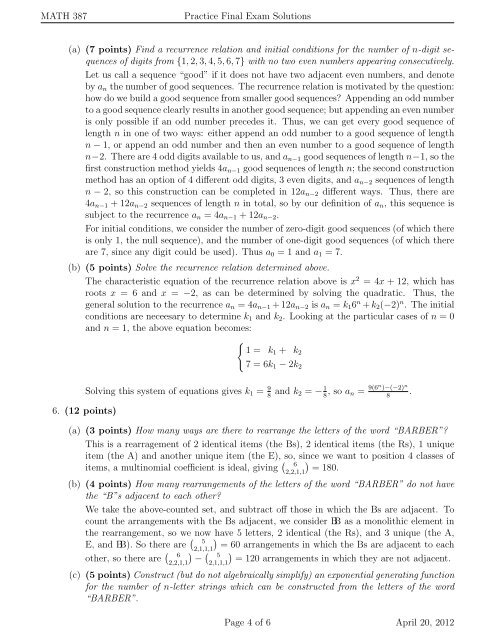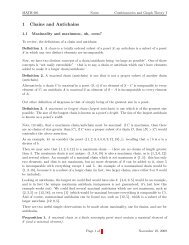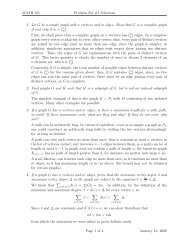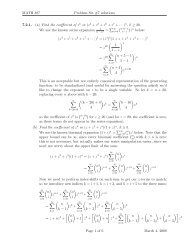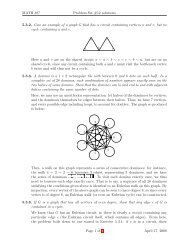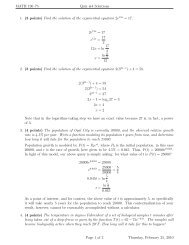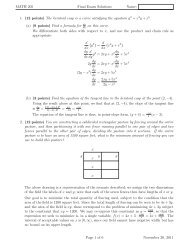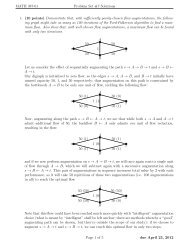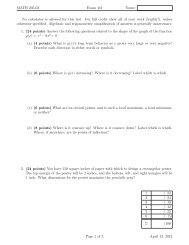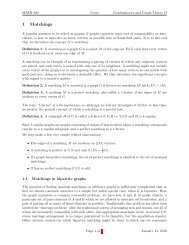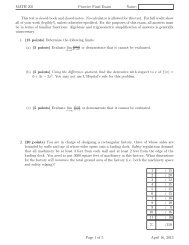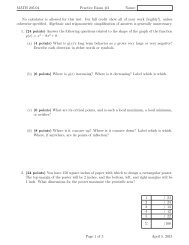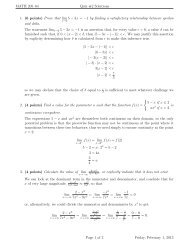MATH 387 Practice Final Exam Solutions 1. (12 points) For the ...
MATH 387 Practice Final Exam Solutions 1. (12 points) For the ...
MATH 387 Practice Final Exam Solutions 1. (12 points) For the ...
You also want an ePaper? Increase the reach of your titles
YUMPU automatically turns print PDFs into web optimized ePapers that Google loves.
<strong>MATH</strong> <strong>387</strong><strong>Practice</strong> <strong>Final</strong> <strong>Exam</strong> <strong>Solutions</strong>(a) (7 <strong>points</strong>) Find a recurrence relation and initial conditions for <strong>the</strong> number of n-digit sequencesof digits from {1,2,3,4,5,6,7} with no two even numbers appearing consecutively.Let us call a sequence “good” if it does not have two adjacent even numbers, and denoteby a n <strong>the</strong> number of good sequences. The recurrence relation is motivated by <strong>the</strong> question:howdowebuildagoodsequencefromsmallergoodsequences? Appendinganoddnumbertoagoodsequenceclearlyresultsinano<strong>the</strong>rgoodsequence; butappendinganevennumberis only possible if an odd number precedes it. Thus, we can get every good sequence oflength n in one of two ways: ei<strong>the</strong>r append an odd number to a good sequence of lengthn−1, or append an odd number and <strong>the</strong>n an even number to a good sequence of lengthn−2. Thereare4odddigitsavailabletous, anda n−1 goodsequencesoflengthn−1, so<strong>the</strong>first construction method yields 4a n−1 good sequences of length n; <strong>the</strong> second constructionmethod has an option of 4 different odd digits, 3 even digits, and a n−2 sequences of lengthn − 2, so this construction can be completed in <strong>12</strong>a n−2 different ways. Thus, <strong>the</strong>re are4a n−1 +<strong>12</strong>a n−2 sequences of length n in total, so by our definition of a n , this sequence issubject to <strong>the</strong> recurrence a n = 4a n−1 +<strong>12</strong>a n−2 .<strong>For</strong> initial conditions, we consider <strong>the</strong> number of zero-digit good sequences (of which <strong>the</strong>reis only 1, <strong>the</strong> null sequence), and <strong>the</strong> number of one-digit good sequences (of which <strong>the</strong>reare 7, since any digit could be used). Thus a 0 = 1 and a 1 = 7.(b) (5 <strong>points</strong>) Solve <strong>the</strong> recurrence relation determined above.The characteristic equation of <strong>the</strong> recurrence relation above is x 2 = 4x + <strong>12</strong>, which hasroots x = 6 and x = −2, as can be determined by solving <strong>the</strong> quadratic. Thus, <strong>the</strong>general solution to <strong>the</strong> recurrence a n = 4a n−1 +<strong>12</strong>a n−2 is a n = k 1 6 n +k 2 (−2) n . The initialconditions are neceesary to determine k 1 and k 2 . Looking at <strong>the</strong> particular cases of n = 0and n = 1, <strong>the</strong> above equation becomes:{1 = k1 + k 26. (<strong>12</strong> <strong>points</strong>)7 = 6k 1 −2k 2Solving this system of equations gives k 1 = 9 8 and k 2 = − 1 8 , so a n = 9(6n )−(−2) n8.(a) (3 <strong>points</strong>) How many ways are <strong>the</strong>re to rearrange <strong>the</strong> letters of <strong>the</strong> word “BARBER”?This is a rearragement of 2 identical items (<strong>the</strong> Bs), 2 identical items (<strong>the</strong> Rs), 1 uniqueitem (<strong>the</strong> A) and ano<strong>the</strong>r unique item (<strong>the</strong> E), so, since we want to position 4 classes ofitems, a multinomial coefficient is ideal, giving ( 62,2,1,1)= 180.(b) (4 <strong>points</strong>) How many rearrangements of <strong>the</strong> letters of <strong>the</strong> word “BARBER” do not have<strong>the</strong> “B”s adjacent to each o<strong>the</strong>r?We take <strong>the</strong> above-counted set, and subtract off those in which <strong>the</strong> Bs are adjacent. Tocount <strong>the</strong> arrangements with <strong>the</strong> Bs adjacent, we consider BB as a monolithic element in<strong>the</strong> rearrangement, so we now have 5 letters, 2 identical (<strong>the</strong> Rs), and 3 unique (<strong>the</strong> A,E, and BB). So <strong>the</strong>re are ( 52,1,1,1)= 60 arrangements in which <strong>the</strong> Bs are adjacent to eacho<strong>the</strong>r, so <strong>the</strong>re are ( ) (62,2,1,1 − 52,1,1,1)= <strong>12</strong>0 arrangements in which <strong>the</strong>y are not adjacent.(c) (5 <strong>points</strong>)Construct (but do not algebraically simplify) an exponential generating functionfor <strong>the</strong> number of n-letter strings which can be constructed from <strong>the</strong> letters of <strong>the</strong> word“BARBER”.Page 4 of 6 April 20, 20<strong>12</strong>


